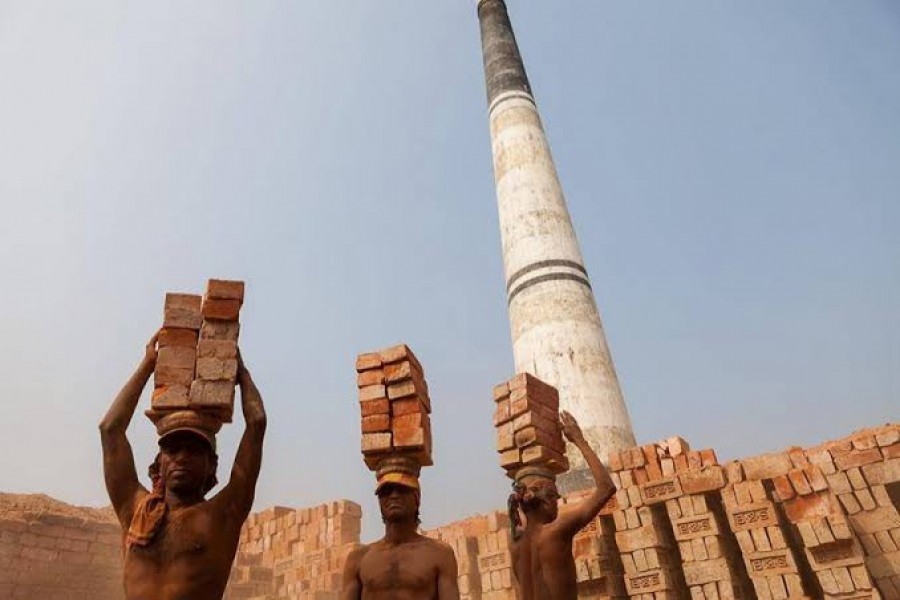The worsening air quality of Dhaka that has placed it at the bottom of all global cities, according to the latest air quality index, did not surprise many, especially the environmentalists who have for long set the alarm bell ringing about the fast deteriorating air quality of the city. Although construction of metro rail is considered responsible to a certain extent by experts, most conscious people including the media are loud in raising protest against the monstrosity of law-defying brick kilns - the main polluter of the capital's air.
The High Court has asked the government last week to constitute a high-powered committee to formulate a guideline in order to reduce air pollution in and around Dhaka city. The court also ordered the authorities concerned to conduct mobile courts to shut down illegal brick fields in five districts, including Dhaka, within 15 days. The four other districts are Narayanganj, Munshiganj, Gazipur and Manikganj where brick kilns are largely contributing to polluting air.
Sprouting of brick kilns irrespective of locations has been on the rise for decades, facilitated largely by the absence of any enforceable rules. The Brick Burning (control) Act 1989 had its inadequacies to dictate terms in the first place, and besides, lacuna in the enforcement of some of the compliance issues made things worse. Resultantly, the practice of setting up brick plants at any location of choice went unopposed. To part with the practice, the government enacted a law on brick production-- the Brick Making and Brickfield Establishment (Control) Act 2013. The purpose was to check widespread environmental pollution as well as save arable land and forest. The previous law, the Brick Burning (control) Act 1989 was amended twice in 1992 and 2001, before it was finally replaced by the new law with stricter measures. The law introduced tougher regulations for brick production, including provision of trial for offences under the penal code. Previously, offences were tried under the environment court.
As things stand now, it is clear that the law failed to rein in the unabated thriving of brick manufacturing that too in violation of the basics of the law. A recent report says the number of brick kilns in the country has increased 59 per cent over the past five years. Another newspaper report says one third of the brick kilns were set up illegally-either without clearance from the Department of Environment or without eco-friendly technology as required under the law.
According to the Department of Environment, there are about 6,500 brickfields in the country. However, environmentalists claim the number to be as high as around 10,000, and half of them are located around the capital. According to a UNDP (United Nations Development Programme) estimate, Bangladesh produces some 8.66 billion bricks a year at a value of $450 million -- almost 1.0 per cent of the country's GDP. Despite the sizeable contribution of brick making to the economy, one of the grim realities is that brick fields all over the country are getting increasingly invasive in grabbing the country's less than sufficient arable lands. More dangerous is the threat that comes in terms of affecting neighbourhood lands under cultivation because of the heat, caustic smoke and dust generated by the brick making plants.
Reports say about half of the bricks in the brick kilns are baked with coal, making them the single largest source of greenhouse gas emissions in the country, with several million tons emitted annually. The brick making industry uses mostly a traditional fixed-chimney kiln system, a thoroughly outmoded and inefficient method reportedly 150 years old. Nearly 80 per cent of the 5,000 brick makers use this traditional technology. A local daily reports that over 6.4 million tonnes of carbon emissions are caused by the brick kilns annually.
Given the prevailing lawlessness, the need for urgent, albeit harsh actions, cannot be ruled out. The High Court directive will hopefully make things easier for the authorities to get into action. Alongside taking actions, one of the options believed to work well is the introduction of modern green technology capable of taking care of the pollution aspect to a great extent. A UNDP funded project Green Brick was initiated in 2010 to introduce modern technology to the country's brick making industry with a shift to greener kilns that experts believe could halve the industry's carbon emissions.
There is thus the need to adopt environment-friendly technologies in the country's brick making sector. The popular and widely accepted technology in this regard is smokeless, energy efficient Hybrid Hoffman Kiln (HHF). It has been gathered that the HHF brick kilns can burn most of the fuel used during firing. This also results in much less energy use and a considerable cut in production costs. The most notable aspect of the technology is that it dries the bricks by directing hot air into the tunnel from the kiln, which blocks carbon emissions.
In view of the wide acceptance of the technology in advanced countries chiefly because of its emission preventing device, Bangladesh should have opted for it long back. The cost of the technology is reportedly high. But keeping in view its efficiency, cost-effectiveness, high scale of production and above all emission-free mechanism, the government may gradually phase out the traditional kilns, and provide necessary support by way of soft-term financing to encourage the green technology.


